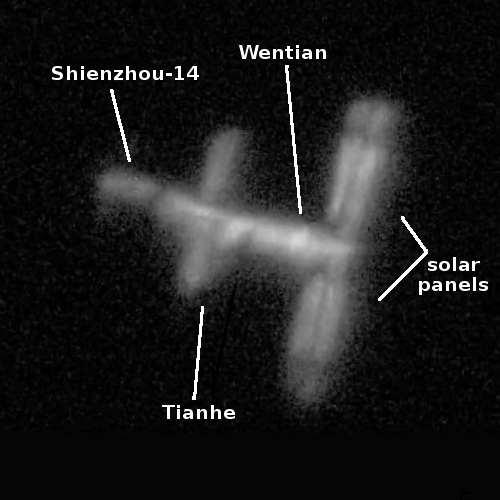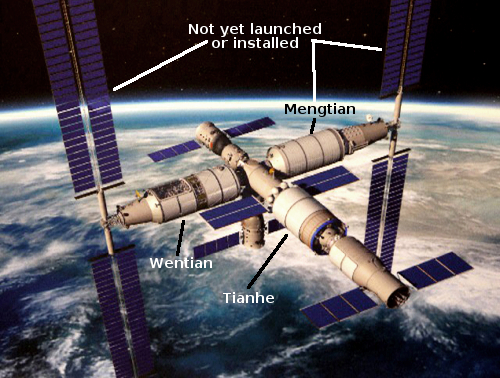China’s Tiangong-3 space station, as seen from the ground

The screen capture to the right was taken by a very short ground-based telescopic movie of China’s Tiangong-3 space station on July 29, 2022. I have labeled it to indicate the various parts of the station, including the new large module, Wentian, that launched to the station on July 24, 2022.
In my original post, I had mislabeled the sections. I have now corrected the image. Thanks to reader Jay for pointing out my error.
Tianhe is the original core module of the station. At present Wentian is in the forward port, so that it and Tianhe lie in a straight line. At some point shortly before the October launch of the next module, Mengtian, they will likely move it 90 degrees to its permanent port to one side, so that Mengtian can dock with the front port where Wentian now sits.
Mengtian will then be shifted 90 degrees to its permanent port on the opposite side of Wentian. At that point the station will form its planned final T-shape configuration.
This dance of spacecraft is necessary to keep the station as balanced as possible to aid in attitude control.

The screen capture to the right was taken by a very short ground-based telescopic movie of China’s Tiangong-3 space station on July 29, 2022. I have labeled it to indicate the various parts of the station, including the new large module, Wentian, that launched to the station on July 24, 2022.
In my original post, I had mislabeled the sections. I have now corrected the image. Thanks to reader Jay for pointing out my error.
Tianhe is the original core module of the station. At present Wentian is in the forward port, so that it and Tianhe lie in a straight line. At some point shortly before the October launch of the next module, Mengtian, they will likely move it 90 degrees to its permanent port to one side, so that Mengtian can dock with the front port where Wentian now sits.
Mengtian will then be shifted 90 degrees to its permanent port on the opposite side of Wentian. At that point the station will form its planned final T-shape configuration.
This dance of spacecraft is necessary to keep the station as balanced as possible to aid in attitude control.

